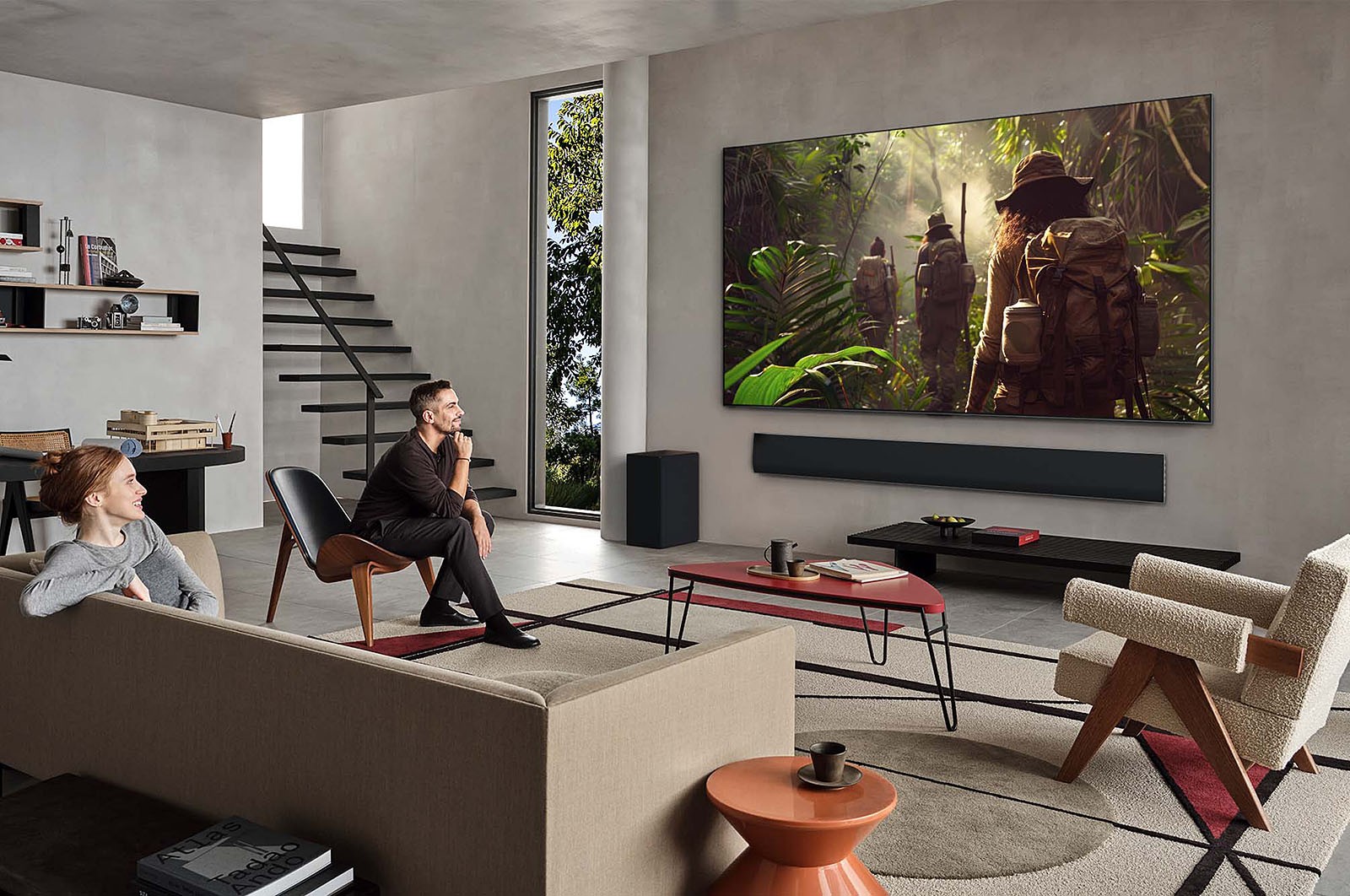To cut a long story short, the LG G5 Oled TV series offers significantly different specifications from the LG G4, mainly due to the abandonment of MLA (Meta 2.0) technology, replaced by the Oled Primary RGB Tandem (Meta 3.0) process unveiled by the Korean group at the CES show in Las Vegas last January (see our LG G5 Evo/M5 Evo news, zoom on the Oled Primary RGB Tandem panels). At the same time, it offers the Brightness Booster Ultimate technology for a (still unofficial) peak brightness of 4,000 nits. With the stated aim of offering the best [abc]Oled[/abc] TVs in the world by 2025.
Tandem Primary RGB Oled Panels, what are they?££££
Behind the name Tandem Oled RGB hides Meta 3.0 technology based on a new Oled panel structure made up of four layers of organic emitting materials, including two layers of blue materials. Surprise, the composition of these layers would not ultimately be the one announced at the beginning of January during the presentation of this new technology at the CES 2025 show in Las Vegas. LG Display's recent statement on this subject contradicts the information gathered on site (see our CES 25 news > Tandem Primary RGB Oled Panel 4,000 nits, have we been lied to?), the blue emitting elements being (late) announced still to be fluorescent and not phosphorescent. The combination of these two blue emitters, mixed with the other red and green phosphorescent organic emitting materials with deuterium (a material already used since the appearance of Oled EX panels in 2022), refines the wavelength of light and improves color purity to offer increased performance in terms of brightness but also color volume. LG Display has continued to perfect this last point, an intrinsic weakness of White Oled technology. We can't wait to judge the brand's claims.
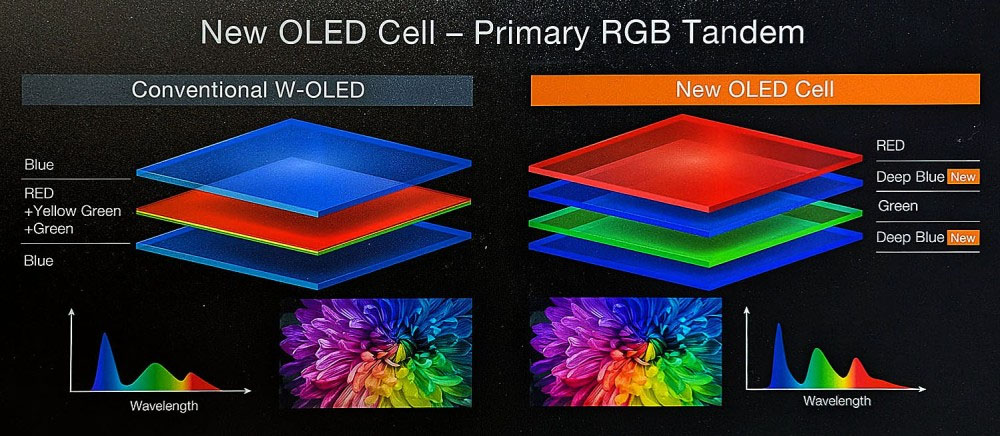
Another advantage highlighted by Tandem Oled RGB technology is a reduced risk of marking (pixel burn-in). Again, this is a point on which LG Display has been working hard since the beginnings of [abc]Oled[/abc] technology. And while significant progress has been made in recent years, the problem persists during specific uses (long video game sessions or broadcasting a news channel with a banner at the bottom of the screen, for example). The Tandem Oled process would be the most significant advance on the subject since the launch of Oled.
In the end, thanks to Tandem Oled RGB technology, the peak brightness of LG G5 Evo TVs is three times greater than that of LG B5 TVs (Editor's note: for a 10% APL). Another figure, LG G5 diffusers offer for a 100% APL (i.e. a completely white screen) a brightness of +40% compared to the LG G4 specimens vintage 2024: we can therefore expect a measurement close to 300 nits. All of this is set to music by the new Alpha 11 Gen 2 central processor.
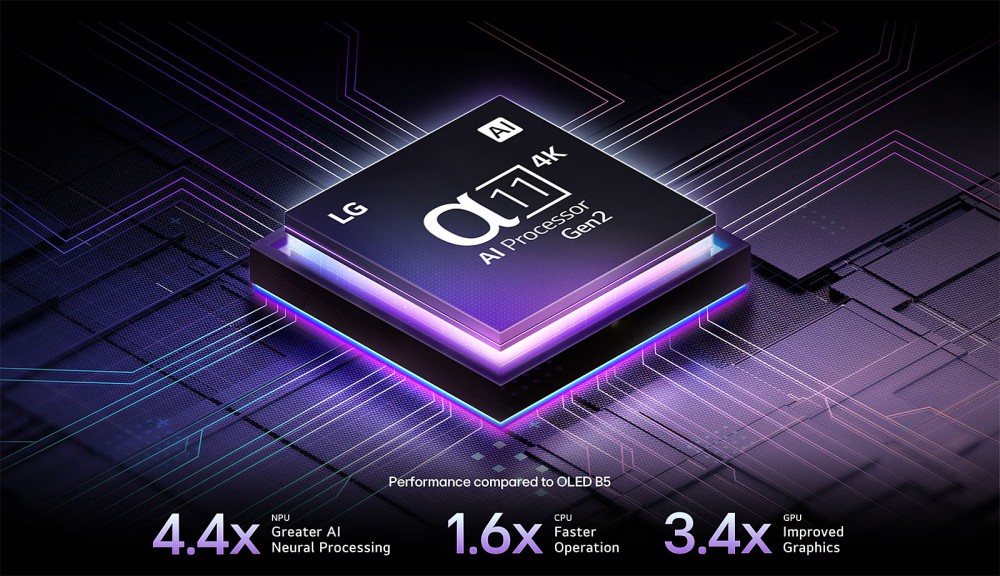
LG G5 Evo Oled TV, UL Intertek certifications££££
Another development of the LG G5 Evo televisions is the UL Intertek Perfect Black Technology and Perfect Color Technology certifications for an environment up to 500 lux. The first guarantees a black level of less than 0.24 nit up to an ambient brightness of 500 lux; the second guarantees constant colors up to 500 lux as well.
LG G5 Evo Oled TV, what diagonals?££££
The LG G5 Evo Oled TV series has six references for as many diagonals: LG OLED48G5 (48'', 122 cm), LG OLED55G5 (55'', 140 cm), LG OLED65G5 (65'', 165 cm), LG OLED77G5 (77'', 196 cm), LG OLED83G5 (83'', 211 cm) and LG OLED97G5 (97'', 246 cm). Note, as with the LG M5 series, the OLED97G5 model does not have Brightness Booster Ultimate technology (Oled Meta 3.0).

Namely, the LG G5 series welcomes in 2025 the 48" diagonal (122 cm) but the latter does not benefit from the Brightness Booster Ultimate function and is limited to a 144 Hz display, against 165 Hz for the 55", 65", 77", 83 inch diagonals. The specimen. The same for the LG OLED97G5 Evo reference limited to 120 Hz and which does not offer the performance of the LG G5 55", 65", 77" and 83" in terms of brightness.
LG G5 Evo Oled TV, what's new again?££££ Among the other new features, we must mention a new Filmmaker mode managed according to ambient light conditions. According to LG, the latter precisely analyzes the light environment in order to automatically adjust the image settings to respect the artistic wishes of the filmmaker. Likewise, the LG G5 Evo boasts Clear100 Vesa certification, ensuring optimal fluidity even when displaying hyper-fast, even syncopated, scenes on the screen. In terms of sound, the AI Sound Pro feature now promises a virtual 11.1.2 environment. Hold on to your hats, the 2025 vintage AI Sound Wizard configuration allows approximately 40 million sound profile variations and 1.6 billion image setting combinations. The chip present in the LG G5 Evo Oled TVs is called Alpha 11Gen 2 and is also new. 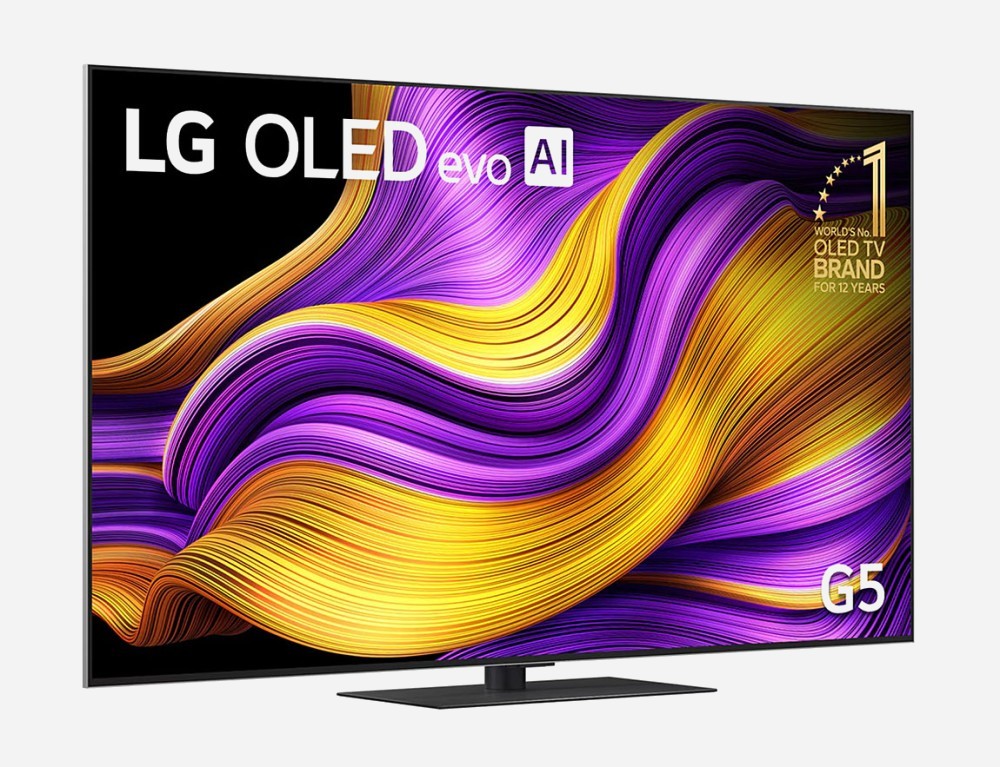
These TVs incorporate the Dynamic Tone Mapping Oled Pro, AI Clear Sound (with Voice Remastering mode to improve dialogue clarity) and Virtual Surround 11.1.2 processes. Likewise, the AI Super Upscaling treatment replaces the AI Upscaling with many improvements (Pixel Detection Upscaling + Visual Detection, Frame + Object Detection Upscaling). We can also mention the AI Director Processing functionality (to respect the tone of the image desired by the director or the DoP).
TV Oled LG G5, main specifications££££
For the rest of the specifications, the Oled LG G5 Evo televisions integrate the new WebOS interface which is guaranteed to be updated for the next four years (see our CES 24 news > LG WebOS Re:New function, 4 years of guaranteed updates), HDR Dolby Vision (now active with Filmmaker mode), HDR Dolby Vision Gaming (120 Hz), HDR Dolby Vision IQ, HDR HLG, Dolby Atmos compatibility. All implemented through a [abc]Oled[/abc] 10-bit [abc]Ultra HD[/abc] 4K flat 165 Hz native panel (except for the 97'', capped at 120 Hz and the 48" capped at 144 Hz) with almost complete coverage of the DCI-P3 color space (99%). We also note the certification with the recent Matter home automation standard.
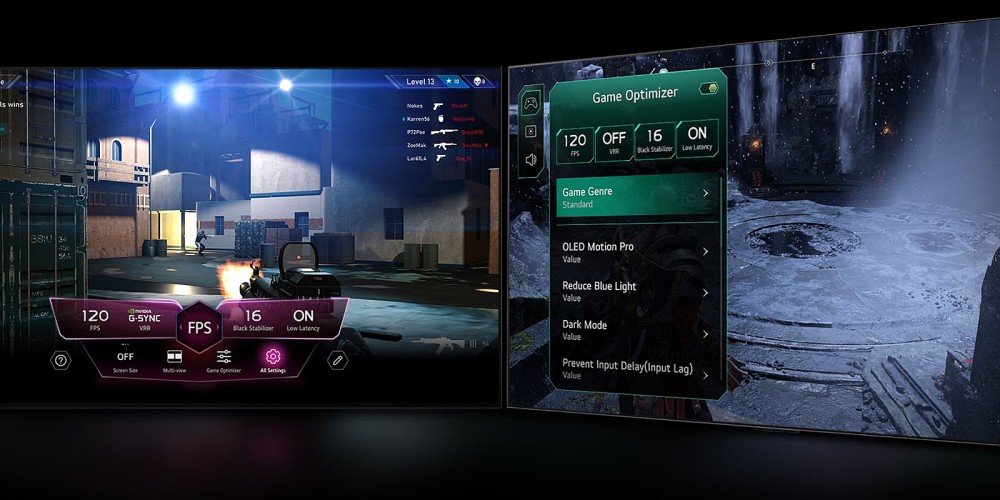
As for the flagship services, GeForce Now, Shadow, Blacknut and Utomik Cloud are still present. The same goes for the 2025 vintage Game Optimizer mode which brings together all the TV settings involved with a video game signal and allows the user to configure them individually as they wish. In 2025, LG G54 TVs benefit from the 144 Hz G-Sync VRR certification in advance (except of course the 97'') in addition to AMD FreeSync.

LG G5 Oled TVs certified Wowcast££££
In 2025, G5 Evo TVs and many of its soundbars will have the Wowcast function (see second photo below). This allows a wireless connection between a TV and a suitable soundbar, capable of transferring a [abc]Lossless[/abc] Dolby Atmos or [abc]DTS:X[/abc] signal, a first.
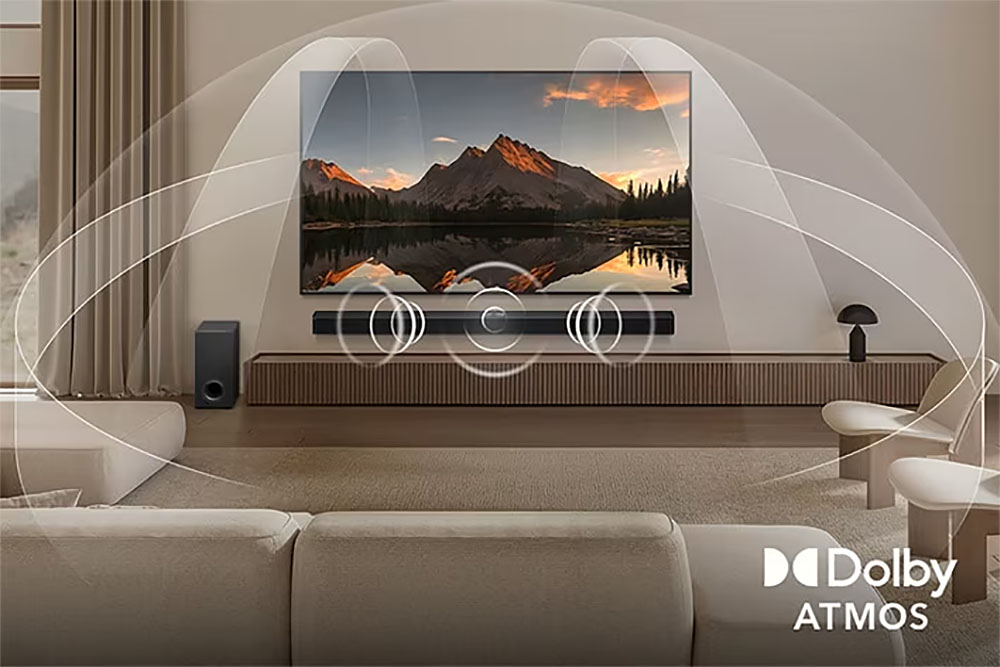
G5 Oled TV, Smart TV ThinQ AI££££
LG OLED G5 screens of course offer the LG ThinQ AI 2025 function with integrated Amazon Alexa and Google Assistant compatibility. These voice assistants are both accessible directly on the remote control via a dedicated button, but also through the TV, without the need for the remote control. In addition to communicating directly with the screen (Google requires a Google Home speaker), it is possible to voice control other Google Assistant and Alexa-certified devices shared on the local network through the TV. This allows access to the internet and specific services (LG App Store online store, chat on social networks, etc.), or even directly to the web as on a computer. Of course, [abc]Miracast[/abc], [abc]Bluetooth[/abc] 5.3, [abc]Wi-Fi[/abc] 6, [abc]Chromecast (integrated)[/abc], [abc]AirPlay 2[/abc] and HomeKit are back on the menu. Otherwise, ThinQ AI is equipped with its own artificial intelligence module to easily and quickly control the television[abc][/abc]: perfect for giving an order to the TV, for example "Turn up the volume" or "Activate Cinema mode".
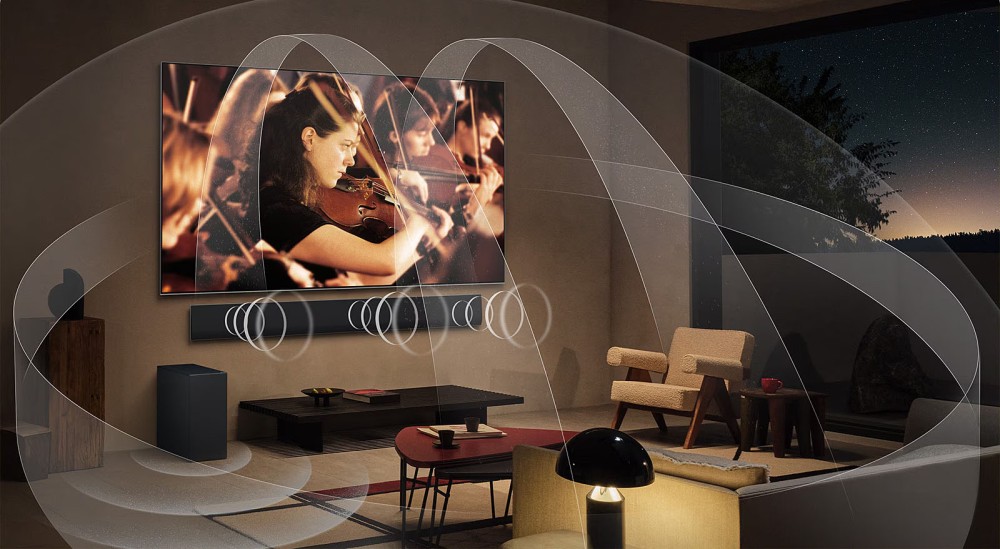
But in 2025, the Korean manufacturer announced the LG AI TV functionality accessible on the remote control via a dedicated button with a specific logo reflecting the "LG AI Home" concept presented by the brand at the IFA show in Berlin last September. In addition to numerous interactions with image processing, LG AI TV naturally intervenes in the use of the TV. Thus, the Voice ID function recognizes the user and automatically switches to their profile with its recommendations and audio-video settings. Also new is the possibility of interrogating the TV and its AI Chatbot to resolve a problem, for example searching for a particular function in the menus or to help select the best settings according to the nature of the content broadcast.
LG G5 Evo Oled TV, and the rest?££££
For the rest, we find on the LG G5 Evo TVs a double tuner [abc]DVB-T[/abc]2, [abc]DVB-S[/abc]2 and [abc]DVB-C[/abc], an Auto Level function (to avoid sudden changes in sound volume when changing sources), Fransat and [abc]Canal Ready[/abc] certifications, [abc]HBBTV[/abc] compatibility, the DVR function to record your favorite programs via one of the three [abc]USB[/abc] Host 2.0 ports on a suitable key or an external [abc]HDD[/abc], all associated with the [abc]Time Shifting[/abc] function. Of course, a virtual keyboard is available via the LG Remote iOS/Android/Windows Phone application to use suitable smartphones/tablets as remote controls.
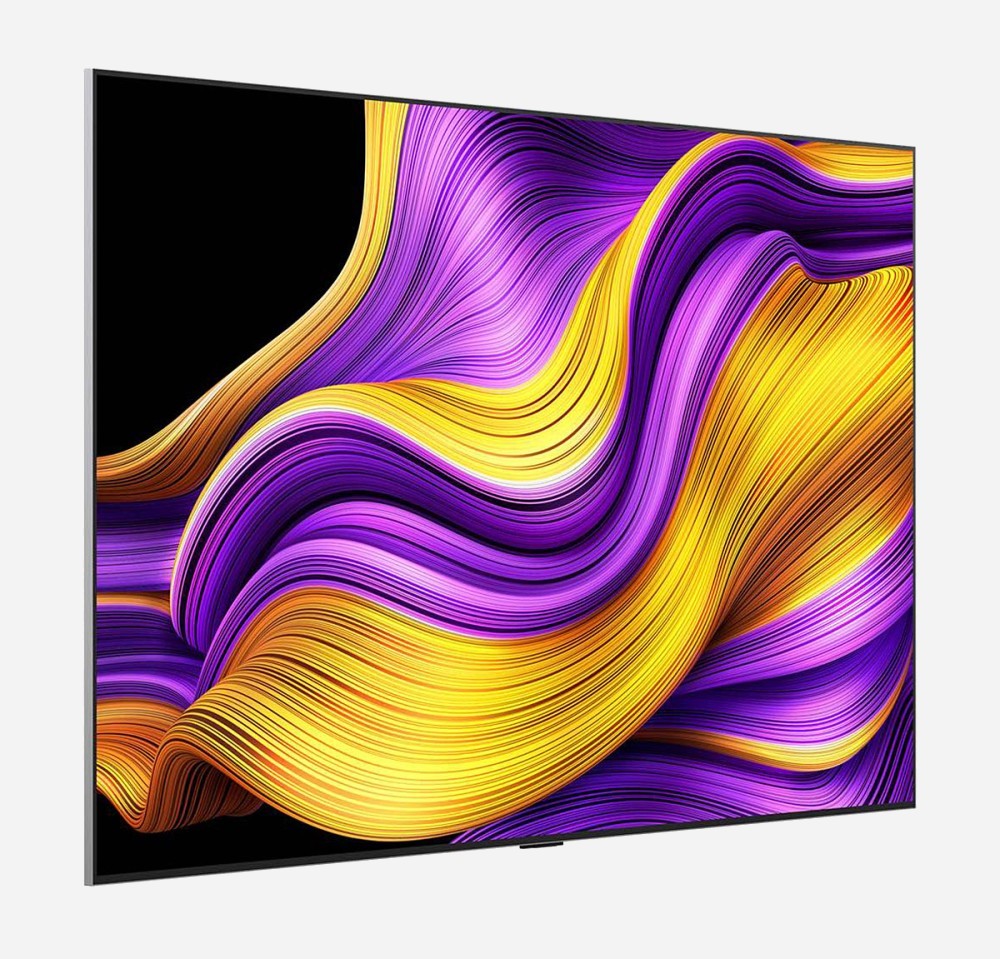
Finally, if LG does not give details on the Input [abc]Lag[/abc] of the Oled 2025 TVs, it should at least be at the level of that of the 2024 TVs, i.e. around 10 ms (6 ms in 4K/120) with the HDR Game mode.
LG G5 Oled TV, HDMI 2.1/HDCP 2.3££££
The LG G5 screens' connectivity includes four [abc]HDMI[/abc] [abc]CEC[/abc] 2.1 inputs certified [abc]HDCP[/abc] 2.3, including one with the [abc]eARC[/abc] function. There is also an [abc]optical[/abc] output, plus three [abc]USB[/abc] Host ports (including one 3.0) compatible [abc]Fat32[/abc] and [abc]NTFS[/abc], a [abc]CI+ port[/abc] and an [abc]Ethernet[/abc] port. In addition to VP9 and AV1, [abc]MP3[/abc], [abc]AAC[/abc], [abc]PCM[/abc], [abc]WMA[/abc], [abc]VC-1[/abc] and [abc]Jpeg[/abc] are supported, with the [abc]MKV[/abc] container.
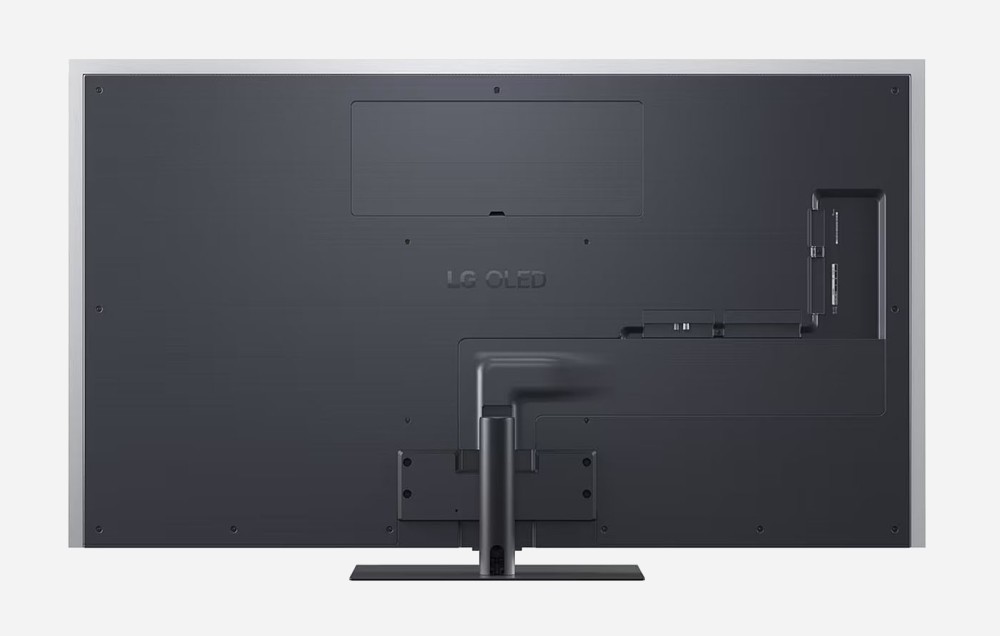
Finally, LG G5 TVs benefit from the five-year Oled Premium warranty, ensuring a standard exchange of the panel in the event of a problem.
More details on the technical specifications in a future update. Availability announced at the end of April. Indicative prices:
• €1,799 for the LG OLED48G5
• €2,299 for the LG OLED55G5
• €3,499 for the LG OLED65G5
• €4,499 for the LG OLED77G5
• €6,499 for the LG OLED83G5
• €24,999 for the LG OLED97G5
Reminder of the key characteristics of LG G5 TVs:
• 10-bit panel
• [abc]Ultra HD[/abc] [abc]4K[/abc] panel
• [abc]Oled[/abc] EVO panel
• Oled Meta 3.0 panel
• 4K/165 Hz panel
• Tandem Oled [abc]RGB[/abc] panel
• Oled Meta 3.0 panel
• Processor: Alpha 11 Gen 2
• Wide Color Gamut function
• Multimedia gateway function [abc]UPnP[/abc] ([abc]DLNA[/abc])
• [abc]eARC[/abc] function
• [abc]VRR[/abc] function
• [abc]ALLM[/abc] (Auto Low Latency Mode)
• Upscaller HDR function
• [abc]Time Shifting[/abc] function
• LG Sound Sync Wireless function
• AI Sound Pro function
• AI Picture Pro function
• Auto Volume Level function
• HDR Dynamic Tone Mapping Pro function
• Game Optimizer function
• AI Super Resolution function
• AI Noise Reduction function
• AI Brightness Control function
• AI Genre Selection function
• Oled Motion function
• AI Director Processing function
• Pixel Detection Upscaling function
• Visual Perception function
• Object Detection Upscaling function
• Virtual Surround 11.1.2 function
• AI Clear function Sound
• Voice Remastering function
• Brightness Booster Ultimate function
• [abc]HDR10[/abc] and [abc]HDR HLG[/abc] compatibility
• [abc]Bluetooth[/abc] compatibility
• [abc]NTFS[/abc] compatibility (via [abc]USB[/abc])
• [abc]Miracast[/abc] compatibility
• [abc]HEVC[/abc] compatibility
• [abc]NFC[/abc] compatibility
• [abc]Dolby Atmos[/abc] compatibility
• [abc]HBBTV[/abc] compatibility
• [abc]Fransat[/abc] compatibility
• Wi-Fi Direct compatibility
• [abc]CEC[/abc] compatibility
• Wisa
• [abc]Canal Ready[/abc] compatibility
• [abc]AV1[/abc] compatibility
• [abc]VP9[/abc] compatibility
• G-Sync compatibility
• [abc]HDCP[/abc] 2.3 compatibility
• HGiG compatibility
• [abc]HDR Dolby Vision[/abc] Gaming (120 Hz) compatibility
• [abc]Wi-Fi[/abc] 6e compatibility
• Wowcast compatibility
• AMD Freesync compatibility
• Filmmaker Mode certification
• Outputs: 1 [abc]optical[/abc] output
• Inputs: 4 [abc]HDMI[/abc] [abc]CEC[/abc] inputs 2.1 certified [abc]HDCP[/abc] 2.3, including one with the [abc]eARC[/abc] function, 3 [abc]USB[/abc] Host ports (including one 3.0) compatible [abc]Fat32[/abc] and [abc]NTFS[/abc], 1 [abc]CI+ port[/abc] and 1 [abc]Ethernet[/abc] port.
• Multimedia [abc]AirPlay 2[/abc]
• Multimedia HomeKit
• Multimedia Amazon Alexa
• Multimedia Google Assistant
• Multimedia LG ThinQ AI
• Multimedia webOS25
• Input Lag: 10 ms (6 ms in 4K/120)
• Tuner Double tuner [abc]DVB-T[/abc]2
• Double tuner [abc]DVB-S[/abc]2
• Double tuner [abc]DVB-C[/abc]
• Sound section: 4.2
• Power: 60 W (4 x 10 W + 20 W)
